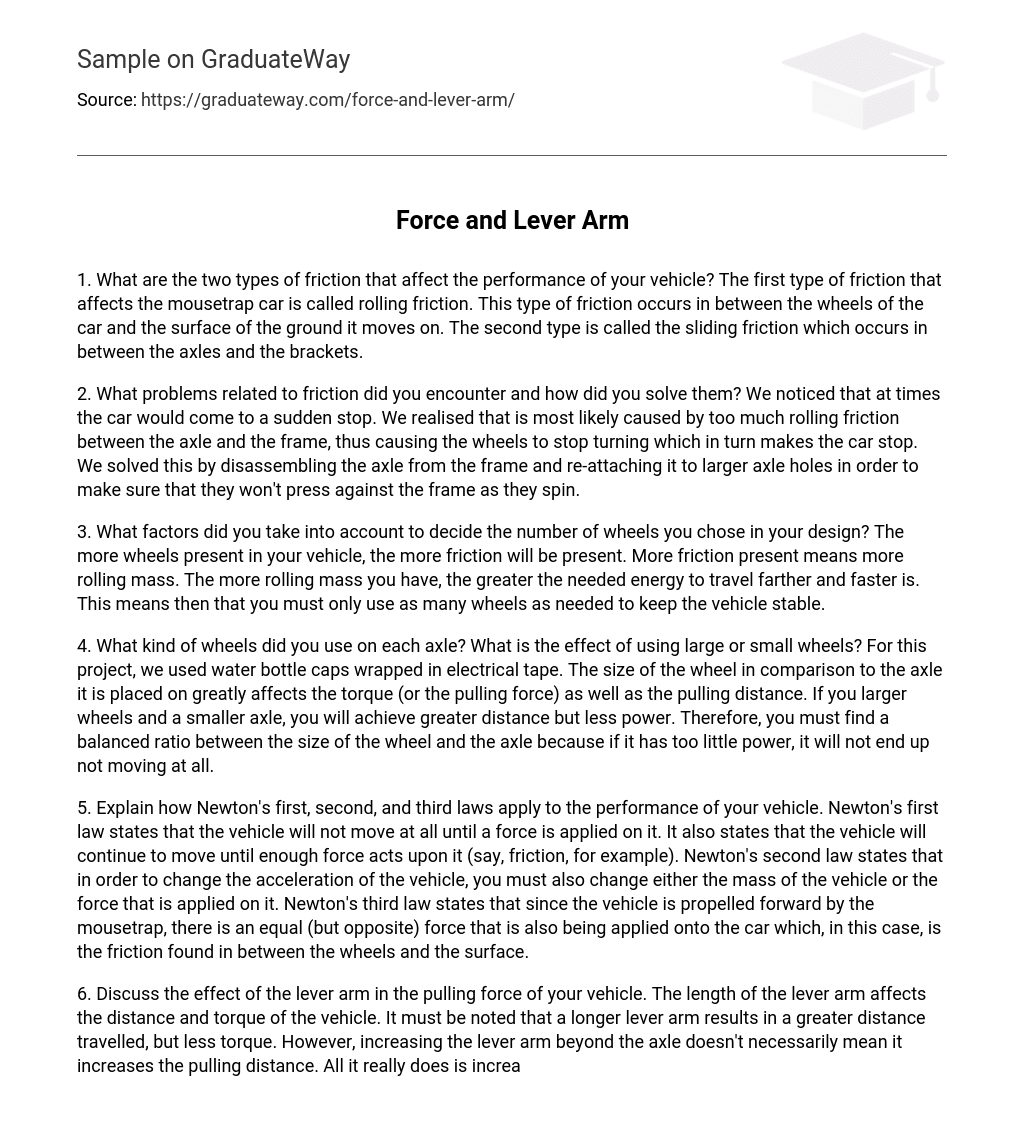1. What are the two types of friction that affect the performance of your vehicle? The first type of friction that affects the mousetrap car is called rolling friction. This type of friction occurs in between the wheels of the car and the surface of the ground it moves on. The second type is called the sliding friction which occurs in between the axles and the brackets.
2. What problems related to friction did you encounter and how did you solve them? We noticed that at times the car would come to a sudden stop. We realised that is most likely caused by too much rolling friction between the axle and the frame, thus causing the wheels to stop turning which in turn makes the car stop. We solved this by disassembling the axle from the frame and re-attaching it to larger axle holes in order to make sure that they won’t press against the frame as they spin.
3. What factors did you take into account to decide the number of wheels you chose in your design? The more wheels present in your vehicle, the more friction will be present. More friction present means more rolling mass. The more rolling mass you have, the greater the needed energy to travel farther and faster is. This means then that you must only use as many wheels as needed to keep the vehicle stable.
4. What kind of wheels did you use on each axle? What is the effect of using large or small wheels? For this project, we used water bottle caps wrapped in electrical tape. The size of the wheel in comparison to the axle it is placed on greatly affects the torque (or the pulling force) as well as the pulling distance. If you larger wheels and a smaller axle, you will achieve greater distance but less power. Therefore, you must find a balanced ratio between the size of the wheel and the axle because if it has too little power, it will not end up not moving at all.
5. Explain how Newton’s first, second, and third laws apply to the performance of your vehicle. Newton’s first law states that the vehicle will not move at all until a force is applied on it. It also states that the vehicle will continue to move until enough force acts upon it (say, friction, for example). Newton’s second law states that in order to change the acceleration of the vehicle, you must also change either the mass of the vehicle or the force that is applied on it. Newton’s third law states that since the vehicle is propelled forward by the mousetrap, there is an equal (but opposite) force that is also being applied onto the car which, in this case, is the friction found in between the wheels and the surface.
6. Discuss the effect of the lever arm in the pulling force of your vehicle. The length of the lever arm affects the distance and torque of the vehicle. It must be noted that a longer lever arm results in a greater distance travelled, but less torque. However, increasing the lever arm beyond the axle doesn’t necessarily mean it increases the pulling distance. All it really does is increase the mass of the vehicle. Aways remember that the lever arm must not be longer than the car.
7. How is the balance of the wheel, around its centre, related to the vehicle’s performance? If the wheels of the vehicles are not balanced well, say if the axle is not centred, it will cause the vehicle to require more energy to move forward because of the rising and falling of the body of the vehicle. If, for example, the wheels aren’t even, the car will wobble as it moves which makes the vehicle slower.
8. How does the distribution of weight of the vehicle affect the traction of the wheels? The traction of the wheels depend mostly on the weight of the vehicle. The greater the mass, the more friction there is. The more friction there is, the more traction there will be. This is why people who drive pick-up trucks place heavy objects at the back during winter. It will cause the car to become heavier thus create more traction in the wheels which lessens the chance of the car sliding off road.
9. Discuss the major problems encountered in the performance of your vehicle and what did you do to solve them.





